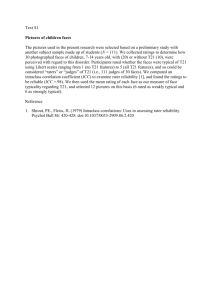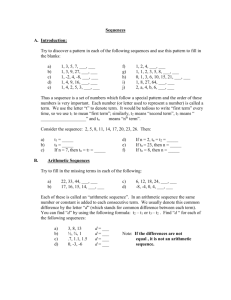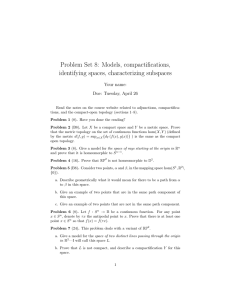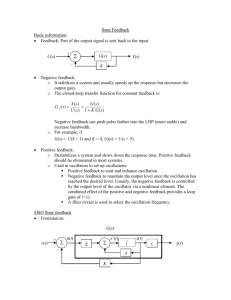Solutions for Problem Set 8: Models, compactifications, identifying spaces, characterizing subspaces
advertisement
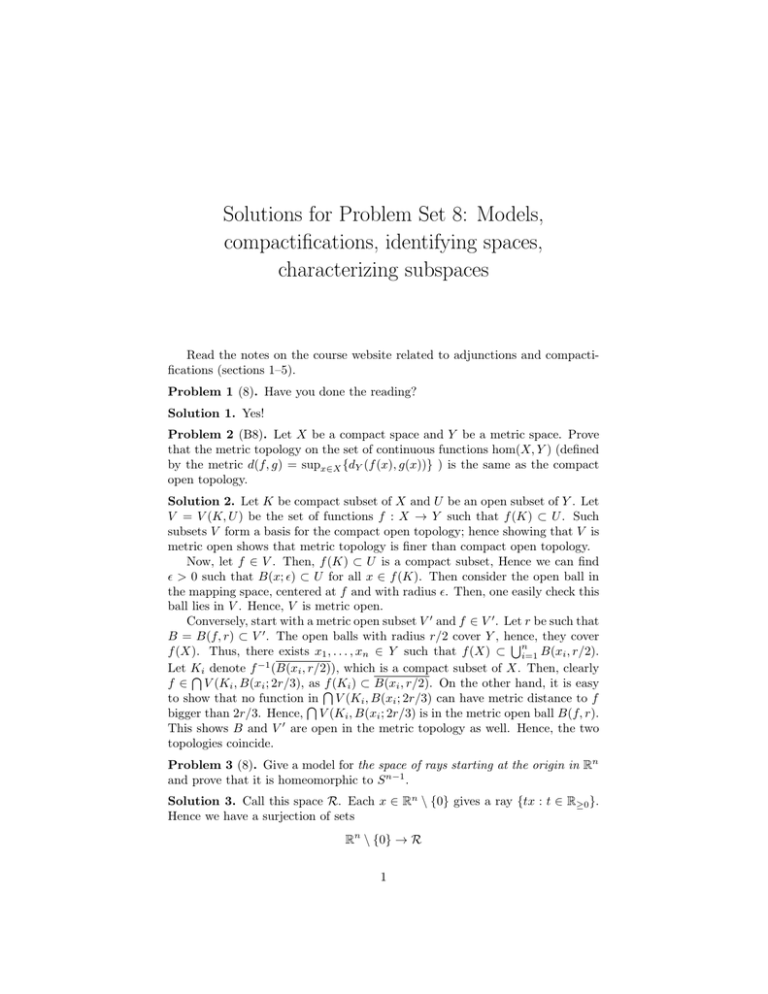
Solutions for Problem Set 8: Models,
compactifications, identifying spaces,
characterizing subspaces
Read the notes on the course website related to adjunctions and compactifications (sections 1–5).
Problem 1 (8). Have you done the reading?
Solution 1. Yes!
Problem 2 (B8). Let X be a compact space and Y be a metric space. Prove
that the metric topology on the set of continuous functions hom(X, Y ) (defined
by the metric d(f, g) = supx∈X {dY (f (x), g(x))} ) is the same as the compact
open topology.
Solution 2. Let K be compact subset of X and U be an open subset of Y . Let
V = V (K, U ) be the set of functions f : X → Y such that f (K) ⊂ U . Such
subsets V form a basis for the compact open topology; hence showing that V is
metric open shows that metric topology is finer than compact open topology.
Now, let f ∈ V . Then, f (K) ⊂ U is a compact subset, Hence we can find
> 0 such that B(x; ) ⊂ U for all x ∈ f (K). Then consider the open ball in
the mapping space, centered at f and with radius . Then, one easily check this
ball lies in V . Hence, V is metric open.
Conversely, start with a metric open subset V 0 and f ∈ V 0 . Let r be such that
B = B(f, r) ⊂ V 0 . The open balls with radius r/2 cover Y , hence,
Sn they cover
f (X). Thus, there exists x1 , . . . , xn ∈ Y such that f (X) ⊂ i=1 B(xi , r/2).
−1
Let K
Ti denote f (B(xi , r/2)), which is a compact subset of X. Then, clearly
f ∈ V (Ki , B(xi ; 2r/3), as T
f (Ki ) ⊂ B(xi , r/2). On the other hand, it is easy
to show that no function T
in V (Ki , B(xi ; 2r/3) can have metric distance to f
bigger than 2r/3. Hence, V (Ki , B(xi ; 2r/3) is in the metric open ball B(f, r).
This shows B and V 0 are open in the metric topology as well. Hence, the two
topologies coincide.
Problem 3 (8). Give a model for the space of rays starting at the origin in Rn
and prove that it is homeomorphic to S n−1 .
Solution 3. Call this space R. Each x ∈ Rn \ {0} gives a ray {tx : t ∈ R≥0 }.
Hence we have a surjection of sets
Rn \ {0} → R
1
The fiber of a ray [x] = R≥0 x is R≥0 x. It is reasonable to endow R with the
quotient topology. If one wants to relate things that he/she already knows, one
can either see it as a subset of the mapping space M ap(R≥0 , Rn ) endowed with
compact open topology, or see it as the set {(l, p) : l ∈ RP2 , p is a direction in l}
and endowed with the coarsest topology making R → RP2 and (l, p) 7→ (l, −p)
continuous. Another way of topologizing this is giving a description of T op( , R),
as the functor that sends a space B into rays parametrized by B, i.e. the set of
closed subsets of B × Rn \ {0} that specialize to a ray over each point of B. Note
I am highly unsure of this last one, check it for yourself. Then, Yoneda tells us
it is uniquely determined in T op and we can check that our model represents it.
Now, my model was Rn \ {0}/ ∼, where ∼ is identifying vectors that are
positive real multiples of each other. But we have a map
p : Rn \ {0} → S n−1
x
. This map is clearly surjective, with the fibers the same as
such that x 7→ ||x||
those of the projection to R. Hence, to show that S n has the quotient topology,
hence homeomorphic to R, we only need to show p is a quotient map. But, this
is easy, it is obviously continuous and open, indeed images of small enough open
balls are open balls again. Hence, we are done.
Problem 4 (16). Prove that RP2 is not homeomorphic to D2 .
Solution 4. The easiest way of proving this would be showing that every loop
in D2 contracts, whereas there are loops in RP2 that does not contract to a
constant loop. Namely, if you have a loop γ : S 1 → D2 , then there exists a path
of loops(see Problem 5), or a map Γ : [0, 1] × S 1 → D2 such that Γ(0, t) = γ(t)
and Γ(1, t) is constant in t (e.g. take Γ(s, t) = (1 − s)γ(t)). You can show this
does not hold for RP2 in various ways. Take for instance the standard quotient
map π : S 2 → RP2 . Take one of the big equitorial circles and parametrize
half of it, which we call θ̃ : [0, 1] → S 2 . Then its endpoints are antipodal to
each other and its image θ = π ◦ θ̃ in RP2 defines a loop. If it contracts as
before, i.e. if there exists a Θ : [0, 1] × [0, 1] → RP2 such that Θ(0, t) = θ(t),
Θ(s, 0) = Θ(s, 1) and Θ(1, t) is constant in t, then one can show this has a
lift Θ̃ : [0, 1] × [0, 1] → S 2 such that Θ̃(0, t) = θ̃(t) and π ◦ Θ̃ = Θ. Then
the endpoints of Θ̃(s, ) are antipodal always(either antipodal or the same as it
projects to Θ, but actually antipodal everywhere as it is antipodal for s = 0)
Hence, this has to be the case for Θ̃(1, t) as well, which projects to a constant
path, hence which is itself constant. This contradiction shows that θ does not
contract, hence the two spaces are not homeomorphic.
Another way would be proceeding locally, namely the boundary points cannot be identified with any point of RP2 under any homeomorphism/diffeomorphism.
Showing this for diffeomorphisms is easier, it just uses basic calculus(there is a
notion of outward tangent vector on the boundary points) A nice, purely topological way of showing this would be as follows: Every boundary point p of D2
has a neighborhood basis {Ui } so that Ui \ {p} is contractible or at least every
loop in it is equivalent in the above sense to a constant loop. But for points
2
q ∈ RP2 , small neighborhoods are homeomorphic to neighborhoods of 0 in R2 .
And one can show if 0 ∈ U ⊂ R2 an open subset, then U \ {0} has circles that
does not contract, e.g. using integration over certain closed 1-forms as explained
in the question below.
Problem 5 (B9). Consider two points, α and β, in the mapping space hom(S 1 , R2 \
{0}).
a. Describe geometrically what it would mean for there to be a path from α
to β in this space.
b. Give an example of two points that are in the same path component of
this space.
c. Give an example of two points that are not in the same path component.
Solution 5.
a. We have the adjunction,
T op(X, hom(Y, Z)) = T op(X × Y, Z)
for nice enough topological spaces(a very geometric start:). Appllied in our
situation, this just tells us that a map from I = [0, 1] to hom(S 1 , R2 \ {0})
is the same thing as a map I × S 1 → R2 \ {0}. Hence, a path from α to
β is just a homotopy,i.e. a map
φ : I × S 1 → R2 \ {0}
such that φ|{0}×S 1 = α and φ|{1}×S 1 = β.
b. Well, we can take α = β and the path/homotopy to be the constant
path/homotopy, i.e. (t, x) 7→ α(x) = β(x). A less cheap example is when
there exists an r > 0 such that α(x) = rβ(x) for all x. Then,
(t, x) 7→ (t − tr + r)β
is such a path.
c. Let α be the standard circle x 7→ x and β be the constant map, x 7→ x0 ,
for a fixed x0 ∈ Rn \ {0}. Now I don’t know how much you have seen
about fundamental groups or covering spaces so far, but an elementary
proof of this can be given as follows:
Consider the 1-form Im( dz
z ), where z = x + iy, i.e. the closed 1-form
xdy−ydx
ω = x2 +y2 . If you parametrize α by θ 7→ (cosθ, sin θ), then you can
R
R
calculate α ω = 2π, whereas β ω = 0. But by Stokes theorem, if they
were related by an homotopy as above, these integrals would be the same.
Hence, they are in different components.
Problem 6 (8). Let f : S n → R be a continuous function. For any point
x ∈ S n , denote by τ x the antipodal point to x. Prove that there is at least one
point x ∈ S n so that f (x) = f (τ x).
3
Solution 6. Consider the function g(x) := f (x) − f (τ x). Notice that,
g(x) = −g(τ x). Hence, g(S n ) is symmetric with respect to 0 ∈ R and connected
as S n is connected. This implies 0 ∈ g(S n ). Hence, there exists an x ∈ S n such
that 0 = g(x) = f (x) − f (τ x). We are done.
Problem 7 (24). This problem deals with a variant of RP2 .
a. Give a model for the space of two distinct lines passing through the origin
in R2 —I will call this space L.
b. Prove that L is not compact, and describe a compactification Y for this
space.
c. What does the space Y \ L look like?
d. When does a continuous function L → R extend to a continuous function
Y → R?
Solution 7.
a. You have seen that RP1 is a model for the space of lines
through the origin. Hence, space of pairs of lines (l1 , l2 ) is RP1 × RP1 .
But, we want only distinct lines, hence take of the diagonal, i.e. consider
M = RP1 × RP1 \ {(l, l) : l ∈ RP1 }. But in M , the set of distinct lines
{l1 , l2 } occurs twice: as (l1 , l2 ) and as (l2 , l1 ). Hence this suggests taling
the quotient of M by the equivalence relation (l1 , l2 ) ∼ (l2 , l1 ), denote the
quotient map by
π:M →L
This is the model for the desired space. Other models can be given by
modifying models of RP1 such as
S 1 × S 1 \ {(x, x)} (x1 , x2 ) ∼ (±x2 , ±x1 )
or
2
2
(R \{0})×(R \{0})\{(x, x)}
(x1 , x2 ) ∼ (r2 x2 , r1 x1 ), r1 , r2 ∈ R\{0}
It is not hard to show they are equivalent. Also, note that by replacing 1
above by n, and 2 by n + 1 we get the same space for Rn+1 .
b. The quotient map
π:M →L
is clearly an open and closed map. Now, M is an open subset of RP1 ×
RP1 , which is itself a Hausdorff and connected space. Hence, M cannot
be closed in there, so it cannot be compact. Now, note an interesting
property of π: For every p ∈ L, there exists a neighborhood U ⊂ L
such that π −1 (U ) = U1 ∪ U2 , where Ui are disjoint, open and π|Ui :
Ui → U is an homeomorphism. This can easily be proven by taking
seperating neighborhoods V1 , V2 of (l1 , l2 ), (l2 , l1 ) ∈ π −1 (p) and letting
U1 = V1 ∩ τ (V2 ) and U2 = τ (U1 ) = V2 ∩ τ (V1 ) and U = π(Ui ).
4
Hence, if L is compact, one can cover it with finitely many compact sets
Fk , k = 1, . . . m each of which lie in an open set like U ⊂ L above. Hence,
the preimage π −1 (Fk ) is homeomorphicSto two disjoint copies of Fk , thus
m
it is compact. This would imply M = k=1 π −1 (Fk ) is compact, but we
showed this is not the case. Hence, L cannot be compact.
Now, the cheapest way of compactifying L is extending the involution τ
to act on RP1 × RP1 , i.e. by (l1 , l2 ) 7→ (l2 , l1 ) and taking the quotient of
RP1 × RP1 . That this is compact is clear, Hausdorff property follows by
normality of RP1 ×RP1 or can be checked by hand, and that L ,→ Y open,
is also clear. Note, making a compactification with 2-point fibers everywhere is trickier, here, we roughly added a point when two lines coincide,
but you can also keep track of the direction the two lines approaching
to each other, and add a limit point for that. We will not pursure this
here.(also this adds one extra point only in dimension 2)
c. Y is obtained by dividing RP1 × RP1 by the equivalence relation (l1 , l2 ) ∼
(l2 , l1 ) and L is obtained by dividing Y \ ∆ by the same relation, where ∆
is the diagonal as above. Now the involution acts trivially on it, in other
words ∆ is invariant under ∼ and π is a bijection on it. This shows that
π|∆ : ∆ → Y \ L
is a bijection. It is clearly continuous and both spaces are compact Hausdorff, hence it is a homeomorphism. Thus the homeomorphism type of
Y \ L is the same as ∆ ∼
= RP1 .
d. Well, I should have taken one point compactification instead:). Anyway,
in this case, the answer is whenever the composition
RP1 × RP1 \ ∆ → L → R
extends to RP1 × RP1 . This is true since if you know there exists an
extension RP1 × RP1 → R, then you already know it is invariant under
(l1 , l2 ) 7→ (l2 , l1 )
(f (l1 , l2 ) = f (l2 , l1 ) is a closed property and holds over the dense subset
RP1 × RP1 \ ∆) I don’t know a good criteria for this, though it is more
visible here, it holds if whenever l1 , l2 , l10 , l20 converges to l ∈ RP1 , then
f (l1 , l2 ) and f (l10 , l20 ) converge to the same real number.
5
